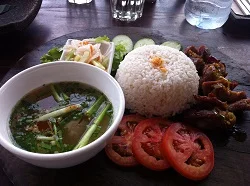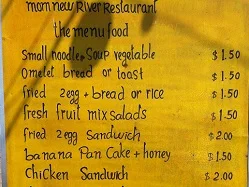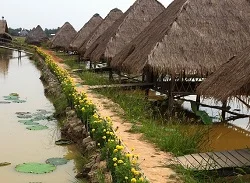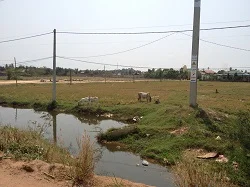What Is It Like In Cambodia?
SwimmingPoolSteve.com is user-supported. In order to keep this resource about pools and spas available for free to all readers I earn commissions for purchases made through links on this page. For more information see the full disclaimer page. By using this website you are agreeing to the terms and conditions.
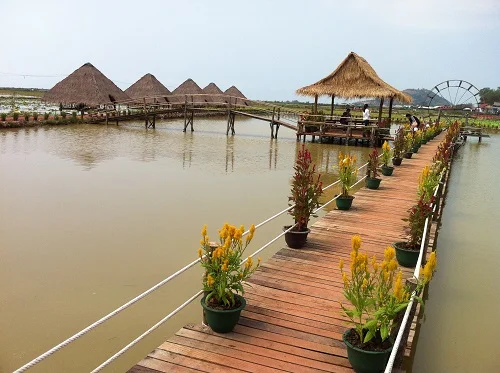 There are hundreds of travel blogs out there from half-starved digital nomads hanging out in Southeast Asia. If you want to learn how to backpack through Cambodia, Thailand, Laos and Vietnam, and find out which hostels have cheapest dorm rooms for rent, go check out one of those other blogs. I can not offer you any special wisdom about how to most effectively travel through this area of the world. What I can do is offer some insight for those who have not been to Cambodia, and more importantly, might not ever go to Cambodia.
There are hundreds of travel blogs out there from half-starved digital nomads hanging out in Southeast Asia. If you want to learn how to backpack through Cambodia, Thailand, Laos and Vietnam, and find out which hostels have cheapest dorm rooms for rent, go check out one of those other blogs. I can not offer you any special wisdom about how to most effectively travel through this area of the world. What I can do is offer some insight for those who have not been to Cambodia, and more importantly, might not ever go to Cambodia.
One thing I have learned, having recently started my new travel blog, is that travel is most certainly not for everyone. To my surprise, the majority of people whom I have spoken with about my travel adventures seemed to disdain the idea of traveling so far from home, and to destinations that are...less comfortable than staying at home.
Or maybe you are interested in Cambodia, and you would travel there tomorrow if you could, but your job or your family prevents this from being a realistic option for you any time in the foreseeable future. In this blog post I will do my best to convey for you what it is like in Cambodia, and specifically Siem Reap. No description could possibly ever replace the experience of going for yourself but in lieu of the ability to go yourself, please feel free to live this experience vicariously through me.

Important notes about Cambodia - This blog post is not a history lesson, but in order to appreciate Cambodia for what it is you need to understand a little bit about the history of Cambodia. Between 1975 and 1979, under orders from Pol Pot, the Khmer Rouge murdered somewhere between 1.5 to 3 million people during the Cambodian genocide. This represented approximately 25% of the entire population of Cambodia at the time. During the resulting war between the Khmer Rouge and the Cambodian government (and Allied Vietnam), over 10,000,000 land mines were buried and continue to detonate, maim and kill people to this day. It is estimated that there may be as many as 4,000,000 to 6,000,000 land mines still buried today throughout Cambodia.
Arriving In Siem Reap
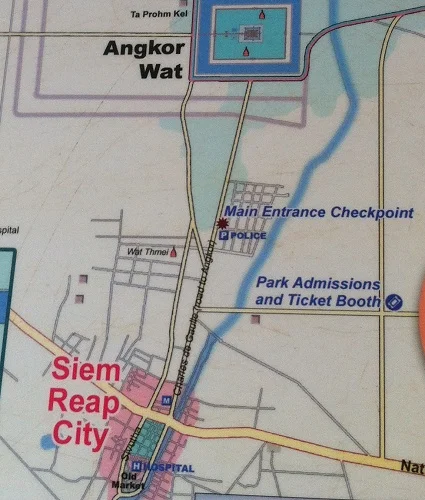 The first thing you see from the air upon arriving in Siem Reap is the Tonle Sap lake that is just South of Siem Reap. When the plane touches down and the doors open you are hit with the heat and jungle humidity that one might expect from most places in Southeast Asia. From this first moment onward you are acutely aware every time that you find yourself in an air conditioned environment as it is noticeably refreshing.
The first thing you see from the air upon arriving in Siem Reap is the Tonle Sap lake that is just South of Siem Reap. When the plane touches down and the doors open you are hit with the heat and jungle humidity that one might expect from most places in Southeast Asia. From this first moment onward you are acutely aware every time that you find yourself in an air conditioned environment as it is noticeably refreshing.
At peak times of year, like March and April when I went, temperatures can climb to 40 degrees Celsius (104 degrees Fahrenheit) or more. Combined with the high levels of humidity this makes it very hard to be outside and you must limit your activities during peak hours of the day when the sun is hottest.
The walk from the airplane to the terminal is short, and the airport is small, and once inside you are greeted with a visa on arrival process that is noticeably bureaucratic. My passport was handed down a line of government workers with each person in the line performing one function. One person to open the passport to the correct page. One person to add a piece of paper to the passport. One person to stamp the piece of paper. One person to line up the passports on the counter, and one person to call out the names of each person to return your passport now complete with a Cambodia travel visa.
It was not an unpleasant process, nor a particularly long one, but a funny first impression of the Kingdom of Cambodia. Passport in hand you now enter through the customs turnstile and head out into Siem Reap.
Turning right out of the airport you start your way down a large paved road that has two smaller paved roads, one on either side. It is quickly apparent that lanes and traffic laws are regarded differently here than you might be used to. Instead of very strict and regimented way of driving like Western countries, driving in Cambodia is based largely on simply going where you want, when you are able to do so. The drive from the airport to downtown Siem Reap is relatively tame. Within about ten minutes or so you turn right off of the main road and onto some smaller, but still mostly paved, roads.

From the airport until the point where you turn away from this main road the streets are lined with large commercial buildings and hotels. There are some smaller buildings and older patchwork homes as well, but mostly larger buildings in this area. As soon as you turn off of the main road however the building styles change. On the smaller side roads you start to see homes and proprietor operated restaurants and businesses.
Dogs are a common sight and while the occasional one might be wearing a collar, the majority are uncollared and unleashed and roaming freely. The dogs seem to have a good sense for traffic and it was interesting to see them looking both ways before crossing the roads. Sadly it is not uncommon to see limping or injured dogs, though this could be from traffic or other problems associated with being a free range dog in Siem Reap.
Of everything that you can not appreciate fully without going in person, for sure the smells are the strongest input you are missing out on. From the moment that you step out into the air in Siem Reap you can smell a faint (and sometimes not so faint) burning smell. Most homes and businesses in this area burn their own garbage in receptacles located near the curb out front of buildings. The acrid smell of smoke permeates Siem Reap and soon you find that you do not even notice it any longer unless you are standing next to a roaring garbage fire.
The smell of the water on the other hand you will certainly notice any time you are near to it. Criscrossing throughout the Siem Reap area are drainage ditches and slow moving (and stagnant) rivers along the sides of the roads. As a swimming pool specialist I am very familiar with the disgusting funk of bacteria laden water. The channels of water that line the roads in Cambodia are a grey-black color, if not blue black, and can be smelled from hundreds of yards away when you are down wind. Of everything that I experienced in Cambodia I found these ultra-disgusting roadside ditches and rivers to be the most appalling thing of all.
I can only image how easily you could get sick from a water borne illness with putrid water so abundant. While I understand that this is a third world country without standards like garbage collection and environmental protection in place, I was still shocked with how much stagnant and filthy water there was. Dirty water can make you sick and even potentially kill you, and some of those baddies like Legionnaires' disease are airborne...scary stuff! You have to remember that I spent the better part of my 25 year career wading around in filthy water that would make most people lose their lunch. I don't want to brag but I am somewhat of a connoisseur of putrid water. A sommelier of a different kind, if you will. The water in the roadside ditches in and around Siem Reap is without question the dirtiest water I have seen and smelled.
Downtown Siem Reap
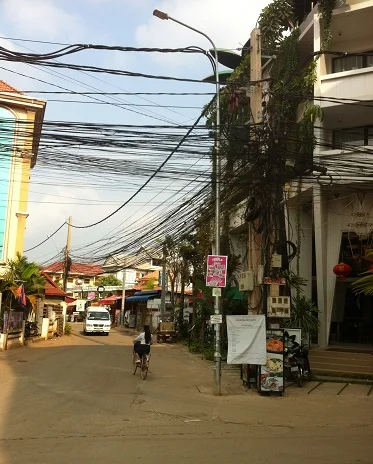
The downtown core of Siem Reap, similar to many major cities, is a vast network of streets, side streets, and back alleys, all largely grouped around major roads and rivers. At near to 200,000 people, while Siem Reap is busy, it does not have a big city feel to it. There are many newly constructed buildings, especially resort hotels, but the majority of the buildings in Siem Reap are low-rise and are tightly packed together.
Siem Reap seems to live around the tourist dollars from people who travel from around the world to visit the Angkor Wat temples which are located only a few minutes away from downtown Siem Reap. The back streets and alleys are lined with stores and vending carts all strategically catering to tourists. Scooters loudly buzz in all directions with the occasional car or truck in with the mix of traffic.
The main roads are fairly well constructed but the side streets are cobbled together in many areas and simply not designed with traffic in mind. This results in pedestrians and motorists alike needing to tread carefully when navigating the busy streets at the city's core.
Pub street is probably the most common tourist hangout with loud, packed bars and restaurants lining the streets. In the evenings this is where all of the action happens in Siem Reap, where obnoxiously loud foreigners drink and eat and party while local vendors and touts apply their trade.
Tuk-tuk drivers line the streets and call out to you, or point, in hopes of getting a fare. Almost all transactions are completed in U.S dollars with only small change being given in Cambodian Riels.
Cash is king here with the vast majority of locals not having bank accounts. In the tourist areas the prices of food and drinks, as well as physical products, is much higher than what locals would pay in the surrounding areas. For example, a beer at an average restaurant on pub street might be anywhere from $1 to $5 USD and mixed drinks average $3 to $7 USD. In areas with less tourists that price drops to around $1. Once you know where to find the cheapest drinks you can find beer specials and small establishments that locals prefer the beer is as little as $0.50 per glass.
 As you walk around the busy downtown area of Siem Reap you will get approached by tuk-tuk drivers, restaurant owners, and store vendors almost constantly. They are very aggressive with their sales pitch despite most having limited english speaking abilities. "Sir" and "lady" are two of the most common words that you will hear as store owners try to get your attention. The more direct ones will simply call out at you "you buy something!" as you walk by their store.
As you walk around the busy downtown area of Siem Reap you will get approached by tuk-tuk drivers, restaurant owners, and store vendors almost constantly. They are very aggressive with their sales pitch despite most having limited english speaking abilities. "Sir" and "lady" are two of the most common words that you will hear as store owners try to get your attention. The more direct ones will simply call out at you "you buy something!" as you walk by their store.
Cambodia is a very poor country and competition for business is fierce since many stores seem to sell the same products and this makes for some very sharp and aggressive touts and sales people. While almost all intend to be friendly, as largely people are in Cambodia, the relentless encouragement to buy things can wear on you after some time.
As you walk down the streets in Siem Reap you will be sharing the roads with other pedestrians but also cars, scooters and even tour busses in some areas. Some common stores that you will pass are restaurants of all size, shape and description, as well as bars, pubs, and hotels. The most common stores other than these would be a fresh frozen ice cream cart, clothing stores (shirts, hats), art stores (sculptures, paintings), shoe stores, massage stores, banks, jewelry stores, pharmacies, and small markets.
The stereotypical fare such as BBQ scorpions, tarantulas, grasshoppers and snakes is not entirely in abundance as you might think. At night I found one vendor that offered these strange items and they seemed to be more of a spectacle than something that people actually wanted to eat.
What Is The Food Like In Cambodia?

I can not speak very much as to the traditional foods of Cambodia other than to comment on the versions that I tried personally. First, I am a tourist, and so I am not privy to know about the secret hot spots that all of the local people eat at. Largely I spent my time in Siem Reap in the tourist areas and so the food was a mixture of local fare and mostly bastardized western dishes.
As a foodie I was a little under whelmed at the local signature dishes I tried like the Amok curry. I was expecting the food to be really spicy like I found in Vietnam. Instead I found the food to be only OK in most of the restaurants that I tried, if not a little bland across the board. In total I probably went to 15 or so different places while in Siem Reap and they were all fairly comparable in both price and quality.
 The prices of food and drinks in Cambodia are probably quite a bit lower in general than the tourist dense sections of Siem Reap that I was in. It seems that many items such as bottles of water, fresh fruit and snacks all cost $1 USD. It is up to you to negotiate these prices lower but most vendors will try to get at least a dollar from you for anything you want.
The prices of food and drinks in Cambodia are probably quite a bit lower in general than the tourist dense sections of Siem Reap that I was in. It seems that many items such as bottles of water, fresh fruit and snacks all cost $1 USD. It is up to you to negotiate these prices lower but most vendors will try to get at least a dollar from you for anything you want.
I bought a banana and the vendor asked for a dollar. I ended up getting a large bunch of bananas for a dollar and I probably still grossly overpaid compared to the going rate for the locals. At a street vendor a 500 ml of water is $1 USD. That same bottle in a corner store might cost $0.50 or $0.60 but the better value would be to buy a 1.5 L bottle for $1 USD or so.
It is helpful to have some Cambodian Riels on hand to negotiate prices lower than one dollar. It is interesting to note that in Cambodia many vendors will not accept damaged notes so any bills with rips in them are likely to be refused, or at best accepted with much chagrin. When receiving change you should check to make sure none of the notes are damaged as it is inconvenient to get rid of one once you have it.
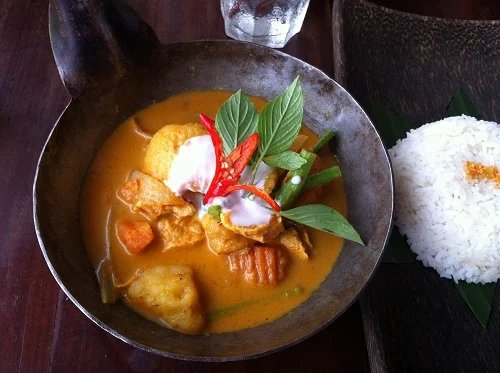 In the tourist restaurants a can of coke or bottle of water is usually around one dollar, and appetizers might be around the $1 to $4 range. The price of entrees will largely depend on the type and quality of the establishment that you are eating at, but anywhere around $3 to $7 was normal for a respectable entree dish.
In the tourist restaurants a can of coke or bottle of water is usually around one dollar, and appetizers might be around the $1 to $4 range. The price of entrees will largely depend on the type and quality of the establishment that you are eating at, but anywhere around $3 to $7 was normal for a respectable entree dish.
You can also get imported meat from Australia and these dishes are usually closer to the $10 to $20 range which is ridiculously high by Cambodian standards. Street food vendors tend to charge around $1 to $2 dollars depending on the size and complexity of the dish you are ordering.
By far the best local food that I had while in Siem Reap was a Amok curry dish with some rice on the side. It was not enough to make me sign up for a Cambodian cooking class the next day, but it still was very enjoyable.
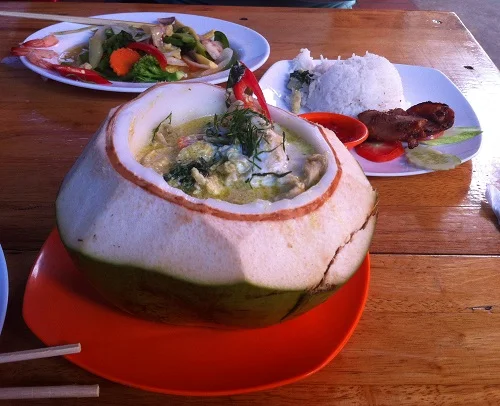 The hardest part about eating in Cambodia is simply the lack of refrigeration and food-safe handling procedures. It is hot in Cambodia and the insects are fairly relentless. Combine this with raw meat at outside air temperature and you have a real potential for food poisoning.
The hardest part about eating in Cambodia is simply the lack of refrigeration and food-safe handling procedures. It is hot in Cambodia and the insects are fairly relentless. Combine this with raw meat at outside air temperature and you have a real potential for food poisoning.
I was able to eat fairly indiscriminately while in Siem Reap and I did not experience any problems at all...but after walking through the open air meat market and seeing the flies everywhere it is harder to enjoy the food that you are ordering. At least that is how I found it to be. I have heard a lot of "old world wisdom" that says that eating spicy food will kill the bacteria and parasites. I have also heard that strong alcohol will do the same but I am skeptical of both of these pieces of advice.
The best thing you can do when traveling to a place where food quality may be an issue is simply to watch what, and where, the locals eat. They know better than you where the freshest foods are available, and more importantly where to avoid.
Cambodian Countryside Around Siem Reap
In the countryside the houses are much farther apart, with groupings together in small villages that you pass along the way. There are a lot of dusty dirt roads and walking trails heading off into the jungle all along the way. Fields of rice and lotus line the roads on both sides and the road is shared by scooters, cars, dump trucks and busses.
It was hard to imagine living out here as we drove by in the relative security of our tuk-tuk. Children walk and ride by on bicycles all along the roadways and locals smile and wave when you do the same. At one point we were passed on the road by a scooter that had a live hog tied upside down on the back seat. That was an interesting sight to say the least and the pig sure looked unhappy about the situation.
What Are The Hotels Like In Cambodia?
As a three star hotel the Rithy Rine Angkor Residence was well outfitted and very elegant feeling. The clean and polished stone work and tile work certainly elevated the feel of this three star, as did the well trained staff, pool area, and restaurant. My hotel was around $25 per night and this included the breakfast buffet. The breakfast included coffee and tea, as well as cold drinks and juice. For cold items there was cereal and fresh milk as well as fruits such as watermelon, pineapple and papaya. For hot breakfast items there was a good selection of buns and bread as well as a daily mixture of scrambled eggs, sausages, sweet and sour veggie stir fry, fried rice and porridge. The spread is designed to suit a little bit from multiple different cultures as the hotel hosts guests from different parts of the world.
 The hotel room included in-room air conditioning as well as a full shower and bathroom. The bed was a queen sized bed which was very firm. Very firm mattresses seem to be common in Asia which works for my sore back...but if you were to fall into bed onto you back you likely would have the wind knocked out of you. The bathroom and shower were both very large, spacious, and clean. The on-demand hot water system generated as much hot water as you needed at any time of day or night.
The hotel room included in-room air conditioning as well as a full shower and bathroom. The bed was a queen sized bed which was very firm. Very firm mattresses seem to be common in Asia which works for my sore back...but if you were to fall into bed onto you back you likely would have the wind knocked out of you. The bathroom and shower were both very large, spacious, and clean. The on-demand hot water system generated as much hot water as you needed at any time of day or night.
The room also came with a balcony which is probably for smoking on as opposed to sight seeing as there is not much to look at other than the roof of the neighboring building. Also included with the room was a safe for storing valuables as well as a small refrigerator that is stocked daily with free water as well as mini bar items such as beer, soda, chocolate and candy.
Hotels in Cambodia usually act as a liaison for you in arranging basic tour activities and transportation. The pickup and drop off services at Siem Reap airport were included with my stay at the hotel. I was also able to arrange tuk tuk rides when I needed to go somewhere including touring the Angkor Wat temples over multiple days. While it is not difficult to find a tuk tuk in Siem Reap, nor is it difficult to arrange transportation to and from the airport or to Angkor Wat, it is very convenient to have everything available in one place at the hotel.

I found restaurants in this area to be somewhat hit and miss and I imagine that hotel breakfast dishes are largely the same. I do not expect a fine dining experience from the free breakfast from my hotel, but I do prefer a breakfast where I can find something worth eating. I think most people would be able to find something that they like from the hotel breakfast if not just a good cup of coffee and some fresh fruit.
Breakfast is usually served all morning from around 6:30 to 10:30 and if you have an all day tour booked most hotels will prepare you a bagged breakfast and lunch to bring with you if you let them know in advance.

Included with this three star hotel is a pool and lounging area outside which is great to have in an area of the world where it gets relentlessly hot. Not all hotels have pools so you need to research where you will be staying if having a pool is important to you. As a swimming pool specialist my criteria for which pools I am comfortable swimming in will be different than yours.
I typically avoid most hotel pools and all hotel hot tubs even in my own country so I am very selective about the pools that I will use in developing countries. In this case the pool was clear and somewhat clear upon our arrival at the hotel, but after some heavy rains at night the pool went green. Other people were using this pool however I did not use it.
Cambodia From An Outsider Perspective
 The most troubling thing about traveling in Cambodia is the noticeable lack of older people. While there are of course some older people in Cambodia there is an eerie-ness to knowing why the ratio of young people to old people is skewed. For my experience in Cambodia I found the people to be generally pleasant, helpful and friendly. The touts and vendors targeting tourists can be too pushy but it is understandable that these people who are working to feed themselves and their families can be too aggressive or too persistent at times. While they can be aggressive this was something that I only encountered while in the busy Siem Reap tourist district. Once outside of the city and into the surrounding countryside, all of the Cambodian people that I encountered were exceedingly friendly and not pushy at all with their wares.
The most troubling thing about traveling in Cambodia is the noticeable lack of older people. While there are of course some older people in Cambodia there is an eerie-ness to knowing why the ratio of young people to old people is skewed. For my experience in Cambodia I found the people to be generally pleasant, helpful and friendly. The touts and vendors targeting tourists can be too pushy but it is understandable that these people who are working to feed themselves and their families can be too aggressive or too persistent at times. While they can be aggressive this was something that I only encountered while in the busy Siem Reap tourist district. Once outside of the city and into the surrounding countryside, all of the Cambodian people that I encountered were exceedingly friendly and not pushy at all with their wares.
Shopping in Cambodia was an interesting experience. I tend to not do much in the way of trinket shopping, but I did need to buy some new shoes while I was there. There were plentiful shoe stores available, each one lined with all the bright and colorful makes and models of shoes I would expect to see in a shoe store back home. While all of the shoes were badged with popular name brand and designer names it was obvious that these were "knock off" products. Prices usually were quoted at around $50 to $100 per pair but after brief negotiations these prices dropped quickly to the $10 to $25 dollar range. I ended up with a comfortable name brand pair of shoes for $13 USD which have help up nicely over time.
 Ultimately Siem Reap is well known for being the gateway to the world famous Angkor Wat temples and this is why most tourists come to this area. This constant influx of tourists daily creates somewhat of a cash-grab society, at least in the tourist dense areas, but by far the worst part of Siem Reap is the other tourists and backpackers in this area. The only time that I saw someone speeding or driving dangerously on the roads it was a tourist. The same goes for being loud, unruly and too drunk - I only ever saw tourists behaving this way.
Ultimately Siem Reap is well known for being the gateway to the world famous Angkor Wat temples and this is why most tourists come to this area. This constant influx of tourists daily creates somewhat of a cash-grab society, at least in the tourist dense areas, but by far the worst part of Siem Reap is the other tourists and backpackers in this area. The only time that I saw someone speeding or driving dangerously on the roads it was a tourist. The same goes for being loud, unruly and too drunk - I only ever saw tourists behaving this way.
I can only hope that this is not the view that Cambodians have about all tourists that come to their Country. Siem Reap in particular is just down the road from the Angkor Wat temples and ruins which are one of the largest tourist attractions in the world. Now that you have somewhat of an idea what it is like in Siem Reap Cambodia you can look forward to my next travel blog post on Angkor Wat and the ancient temples near Siem Reap.
Swimming Pool Steve Travel Blog
Swimming Pool Steve Pool Blog
Swimming Pool Steve Cooking Blog
Top content from www.SwimmingPoolSteve.com
Pool and spa chemistry crash course
New pool owner guide
The Swimming Pool Steve blog
Have a question - ask Steve

Swimming Pool Steve is an award winning, second generation swimming pool specialist from Ontario Canada and one of the most trusted voices in the swimming pool industry. With over 20,000,000 views on the Swimming Pool Steve YouTube Channel, winner of the Pleatco Pool & Spa Industry Leadership award and author of hundreds of pool and spa articles both online and in print. Steve is committed to helping pool and spa owners as well as pool and spa industry workers learn more about the technical side of building, renovating, repairing and maintaining all types of swimming pools and spas. Follow Swimming Pool Steve on Facebook, Twitter and YouTube.
Paid PDF Books From Swimming Pool Steve
 Steve's Pool Survival Guide
Steve's Pool Survival Guide
The Swimming Pool Steve Pool Survival Guide is intended to help pool owners understand their pool and pool equipment better, understand water chemistry, water testing and chemical corrections to the water, troubleshoot the most common pool problems and have confidence in interacting and caring for their pool in the fastest possible frame of time. Also covers pool safety, things to avoid and how to operate your pool more efficiently.
 New Pool Installation Value Guide
New Pool Installation Value Guide
This is a value shopping guide written by Swimming Pool Steve to help home owners hiring for a new pool installation to get the maximum value for their investment with tips about how to protect your interests during the vetting, hiring and pool installation process. Anyone serious about having a pool installed will find value in this guide. Pool installers will sell the pool package that is best for them - not for you! Become an informed value shopper with this PDF guide.
Endorsed Brands From Swimming Pool Steve
The following links and products are to affiliates of the Swimming Pool Steve website. These are brands, products and services hand selected by Steve for endorsement. Please note that these endorsements can include monetary compensation, affiliate links and referral fees to Swimming Pool Steve, however there is zero additional cost to you should you use one of these products or services. Income generated from these links helps to keep this pool and spa resource available for everyone. To have your product or service considered for listing here as an endorsed brand email SwimmingPoolSteve@gmail.com.
Amazon Disclosure Statement - As an Amazon Associate I earn from qualifying purchases.

www.PoolPartsToGo.com
New Black + Decker variable speed pumps are available online from www.PoolPartsToGo.com and they are a drop in replacement for many popular pump models including Pentair Superflo and Hayward Super Pumps. With an adjustable platform base, union connections included and a very strong warranty these pumps offer an impressive value to pool owners.
- Swimming Pool Steve







